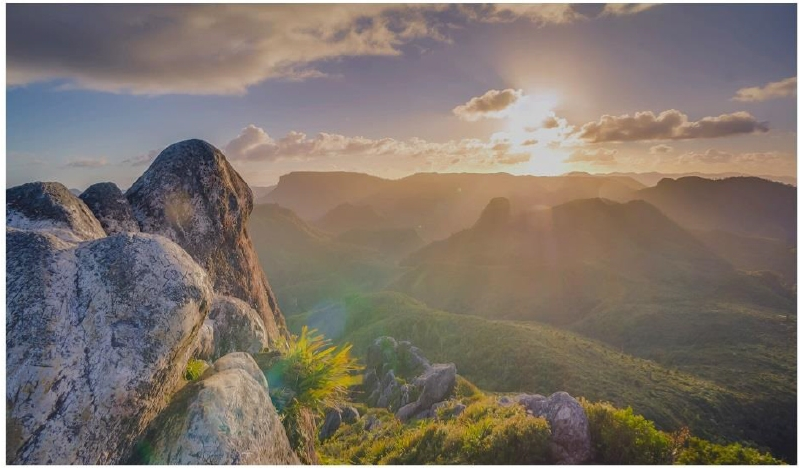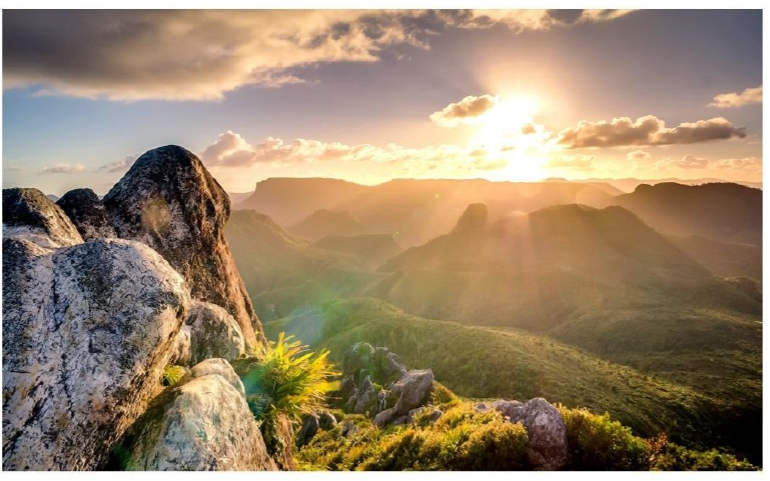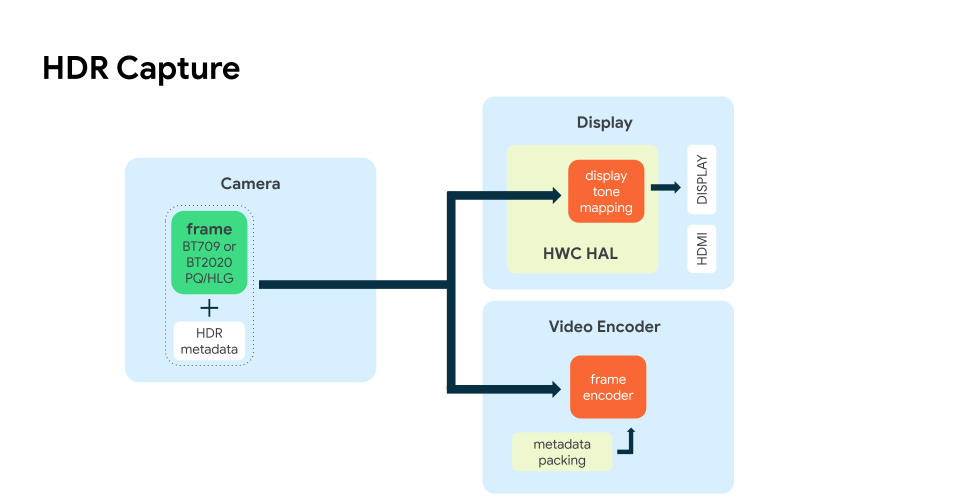Note: This page refers to the Camera2 package. Unless your app requires specific, low-level features from Camera2, we recommend using CameraX. Both CameraX and Camera2 support Android 5.0 (API level 21) and higher.
The Camera2 APIs support High Dynamic Range (HDR) video capture, which enables you to preview and record HDR video content using your camera. Compared to Standard Dynamic Range (SDR), HDR offers a wider range of colors and increases the dynamic range of the luminance component (from the current 100 cd/m2 to 1000s of cd/m2). This results in video quality that more closely matches real life, with richer colors, brighter highlights, and darker shadows.
See how HDR video captures a sunset in more vibrant detail.


Device prerequisites
Not all Android devices support HDR video capture. Before capturing HDR video in your app, determine if your device meets the following prerequisites:
- Targets Android 13 (API level 33).
- Has a 10-bit or higher capable camera sensor. For more information about HDR Support, see Check for HDR support.
Because not all devices meet the prerequisites, you can add a separate code path when setting up HDR video capture in your app. This lets your app fall back to SDR on incompatible devices. Also, consider adding a UI option for SDR. The user can then toggle between SDR and HDR for their video recording needs.
HDR capture architecture
The following diagram shows the main components of the HDR capture architecture.

When a camera device captures a frame in HDR, the Camera2 framework allocates
a buffer that stores the processed camera sensor output.
It also attaches the respective HDR metadata if required by the HDR profile.
The Camera2 framework then queues the populated buffer for the output surface
referenced in the CaptureRequest, such as a display or
video encoder, as shown in the diagram.
Check for HDR support
Before capturing HDR video in your app, determine if the device supports your desired HDR profile.
Use the CameraManager getCameraCharacteristics() method to obtain a
CameraCharacteristics
instance, which you can query for your device’s HDR capabilities.
The following steps check if a device supports HLG10. HLG10 is the baseline HDR standard that device makers must support on cameras with 10-bit output.
First, check if the device supports 10-bit profiles (the bit-depth for HLG10):
Kotlin
private fun isTenBitProfileSupported(cameraId: String): Boolean { val cameraCharacteristics = cameraManager.getCameraCharacteristics(cameraId) val availableCapabilities = cameraCharacteristics.get(CameraCharacteristics.REQUEST_AVAILABLE_CAPABILITIES) for (capability in availableCapabilities!!) { if (capability == CameraMetadata.REQUEST_AVAILABLE_CAPABILITIES_DYNAMIC_RANGE_TEN_BIT) { return true } } return false }
Next, check if the device supports HLG10 (or another supported profile):
Kotlin
@RequiresApi(api = 33) private fun isHLGSupported(cameraId: String): Boolean { if (isTenBitProfileSupported(cameraId)) { Val cameraCharacteristics = cameraManager.getCameraCharacteristics(cameraId) val availableProfiles = cameraCharacteristics .get(CameraCharacteristics.REQUEST_AVAILABLE_DYNAMIC_RANGE_PROFILES)!! .getSupportedProfiles() // Checks for the desired profile, in this case HLG10 return availableProfiles.contains(DynamicRangeProfiles.HLG10) } return false; }
If the device supports HDR, isHLGSupported() always return true.
For more information, see the
CameraCharacteristics
reference documentation.
Set up HDR capture
After ensuring that your device supports HDR, set up your app to capture
a raw HDR video stream from the camera.
Use setDynamicRangeProfile() to provide the stream’s OutputConfiguration
with a device-supported HDR profile, which is then passed
to the CameraCaptureSession
upon creation.
See the list of supported HDR profiles.
In the following code sample, setupSessionDynamicRangeProfile() first checks
that the device is running Android 13.
Then, it sets up the CameraCaptureSession with the device-supported
HDR profile as an OutputConfiguration:
Kotlin
/** * Creates a [CameraCaptureSession] with a dynamic range profile. */ private fun setupSessionWithDynamicRangeProfile( dynamicRange: Long, device: CameraDevice, targets: List, handler: Handler? = null, stateCallback: CameraCaptureSession.StateCallback ): Boolean { if (android.os.Build.VERSION.SDK_INT >= android.os.Build.VERSION_CODES.TIRAMISU) { val outputConfigs = mutableListOf () for (target in targets) { val outputConfig = OutputConfiguration(target) //sets the dynamic range profile, for example DynamicRangeProfiles.HLG10 outputConfig.setDynamicRangeProfile(dynamicRange) outputConfigs.add(outputConfig) } device.createCaptureSessionByOutputConfigurations( outputConfigs, stateCallback, handler) return true } else { device.createCaptureSession(targets, stateCallback, handler) return false } }
}
When your camera app initializes the camera, it sends a
repeating
CaptureRequest
to preview the recording:
Kotlin
session.setRepeatingRequest(previewRequest, null, cameraHandler)
And also to start the video recording:
Kotlin
// Start recording repeating requests, which stops the ongoing preview // repeating requests without having to explicitly call // `session.stopRepeating` session.setRepeatingRequest(recordRequest, object : CameraCaptureSession.CaptureCallback() { override fun onCaptureCompleted(session: CameraCaptureSession, request: CaptureRequest, result: TotalCaptureResult) { if (currentlyRecording) { encoder.frameAvailable() } } }, cameraHandler)
Encode the HDR camera stream
To encode the HDR camera stream and write the file to disk,
use MediaCodec.
First, get the OutputSurface,
which maps to a buffer that stores raw video data.
For MediaCodec,
use createInputSurface().
To initialize MediaCodec, an app must create a
MediaFormat with a specified
codec profile, color space, color range, and transfer function:
Kotlin
val mimeType = when { dynamicRange == DynamicRangeProfiles.STANDARD -> MediaFormat.MIMETYPE_VIDEO_AVC dynamicRange < DynamicRangeProfiles.PUBLIC_MAX -> MediaFormat.MIMETYPE_VIDEO_HEVC else -> throw IllegalArgumentException("Unknown dynamic range format") } val codecProfile = when { dynamicRange == DynamicRangeProfiles.HLG10 -> MediaCodecInfo.CodecProfileLevel.HEVCProfileMain10 dynamicRange == DynamicRangeProfiles.HDR10 -> MediaCodecInfo.CodecProfileLevel.HEVCProfileMain10HDR10 dynamicRange == DynamicRangeProfiles.HDR10_PLUS -> MediaCodecInfo.CodecProfileLevel.HEVCProfileMain10HDR10Plus else -> -1 } // Failing to correctly set color transfer causes quality issues // for example, washout and color clipping val transferFunction = when (codecProfile) { MediaCodecInfo.CodecProfileLevel.HEVCProfileMain10 -> MediaFormat.COLOR_TRANSFER_HLG MediaCodecInfo.CodecProfileLevel.HEVCProfileMain10HDR10 -> MediaFormat.COLOR_TRANSFER_ST2084 MediaCodecInfo.CodecProfileLevel.HEVCProfileMain10HDR10Plus -> MediaFormat.COLOR_TRANSFER_ST2084 else -> MediaFormat.COLOR_TRANSFER_SDR_VIDEO } val format = MediaFormat.createVideoFormat(mimeType, width, height) // Set some properties. Failing to specify some of these can cause the MediaCodec // configure() call to throw an exception. format.setInteger(MediaFormat.KEY_COLOR_FORMAT, MediaCodecInfo.CodecCapabilities.COLOR_FormatSurface) format.setInteger(MediaFormat.KEY_BIT_RATE, bitRate) format.setInteger(MediaFormat.KEY_FRAME_RATE, frameRate) format.setInteger(MediaFormat.KEY_I_FRAME_INTERVAL, IFRAME_INTERVAL) if (codecProfile != -1) { format.setInteger(MediaFormat.KEY_PROFILE, codecProfile) format.setInteger(MediaFormat.KEY_COLOR_STANDARD, MediaFormat.COLOR_STANDARD_BT2020) format.setInteger(MediaFormat.KEY_COLOR_RANGE, MediaFormat.COLOR_RANGE_LIMITED) format.setInteger(MediaFormat.KEY_COLOR_TRANSFER, transferFunction) format.setFeatureEnabled(MediaCodecInfo.CodecCapabilities.FEATURE_HdrEditing, true) } mediaCodec.configure(format, null, null, MediaCodec.CONFIGURE_FLAG_ENCODE)
For more details about implementation, see the Camera2Video sample app’s
EncoderWrapper.kt.
HDR formats
Starting in Android 13, camera devices with 10-bit output capabilities must support HLG10 for HDR capture and playback. In addition, device makers can enable any HDR format of their choosing using the HDR capture architecture.
The following table sums up the available HDR formats and their capabilities for HDR video capture.
| Format | Transfer Function (TF) | Metadata | Codec | Bit Depth |
|---|---|---|---|---|
| HLG10 | HLG | No | HEVC | 10-bit |
| HDR10 | PQ | Static | HEVC | 10-bit |
| HDR10+ | PQ | Dynamic | HEVC | 10-bit |
| Dolby Vision 8.4 | HLG | Dynamic | HEVC | 10-bit |
Resources
For a working app with HDR video capture functionality, see the Camera2Video sample on GitHub.
